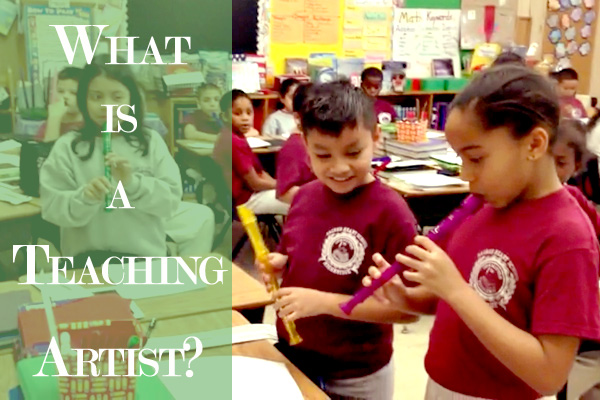A performing artist, traditionally, does not engage in arts education, and arts educators do not consider themselves professional performers. With the growing concern about the aging of audiences and the fluctuations in societal artistic interests (primarily the current lack of interest in the classical arts), some performers have begun to rethink their roles as artists and their disconnect from the education of the arts. A new, hybrid teaching path has emerged from this burgeoning confluence of artist and educator – namely, The Teaching Artist.
Eric Booth, one of the pioneers in this new field, defines a teaching artist as “a practicing professional artist with the complementary skills, curiosities and sensibilities of an educator, who can effectively engage a wide range of people in learning experiences in, through, and about the arts.” Teaching artists exist in all arts fields, and active in two areas: as arts practitioner and as educator. Teaching artists are active performers and artists, affording them the growth and perspective gained from the problem solving, artistic and intellectual curiosity, and discipline employed everyday as an active artist. At the same time, teaching artists are committed educators, employing these same skills in their teaching.
You are now probably wondering how a teaching artist differs from a more traditional arts educator. The primary difference is that teaching artists offer supplemental artistic and learning experiences that typically relate to a particular performance or residency and reflect the individual performing artist’s area of interest and expertise. The primary goal of a teaching artist is to positively enhance one’s experience with a work of art through some kind of interactive, hands-on, creative, experiential, multi-modal process, thus effectively creating an environment in which one can more deeply engage with the work of art at hand.
Teaching Artists work within many different parameters.
- K-12 school partnerships and residencies – These are often created and managed by larger organizations such as symphony orchestras and large arts institutions.
- Residencies with a community arts organization, school, retirement communities, churches, prisons, and hospitals – These residencies are often created, developed, and managed by solo teaching artists or small ensembles.
- The performance stage – Teaching artists are using the stage, during performances, to more fully engage their audiences through guided listening and sometimes even short activities.
My own experiences as a teaching artist first began as a Morse Fellow, a fellowship offered at the Juilliard School to only a select few students. Now, as a member of the New York Philharmonic Teaching Artist faculty, I work with 3rd-5th grade students in public and private schools throughout the five boroughs of New York City. The majority of these students do not receive any other musical training or arts education. Watching these children engage and create personal meaning with a work of musical art is a thrilling and rewarding experience! Not to mention the amazing creativity they exhibit in their own musical compositions and performances.
Teaching artists have the unique ability within the arts community to focus on their area of expertise as a performer and provide a one-of-a-kind educational experience. They also have the permeability to move in and out of different organizations and communities, molding and tailoring their mode of performance and art-piece based education to a specific community or audience. It is this flexibility that makes teaching artists such an invaluable and perhaps the most vital element in the movement to re-engage audiences and societies in general with the arts.
I would love to hear about your first-hand experience with a teaching artist. In what kind of setting did you experience the work of art in a new way? If you are a teaching artist, what have been some of your lost rewarding experiences?
